119 calories (1/2 of recipe); 15.4 g protein; 1.4 g fat; 9.9 g carbohydrate; 8.3 g net carbs; 177 mg sodium; 31 mg cholesterol; 1.7 g fiber
<Ingredients>
Pinch salt (to sprinkle on fish; not in photo)
1 tbsp sake (to sprinkle on fish; not in photo)
3 (200-250 g) kabu Japanese turnip (223g in photo)
20-30 g nagaimo Chinese yam (33 g in photo; 22 g after skinning)
5 cm carrot (9 g in photo)
Several stems (approx. 10g) mitsuba (9 g in photo)
1/3 (approx. 10 g) egg white
1/4 tsp shiokoji salted rice malt
For gin-an thickened dashi sauce
100 cc dashi
1/4 tsp sake
1/4 tsp mirin
1/4 tsp usukuchi soy sauce
1/3 tsp shiokoji salted rice malt
2 tsp katakuriko potato starch + 1 tsp water
1 tsp wasabi powder (not in photo)
<Directions>
1.
Sprinkle salt and sake over fish, and let sit in fridge for 10-15 minutes.
2.
Grate kabu.
(Let it naturally drain by placing on zaru strainer, if available.)
3.
Start boiling water for steamer.
4.
Grate nagaimo.
Jullienne carrot, and chop mitsuba.
Mix wasabi powder with small amount of water.
5.
Add shiokoji to egg white, and whisk until soft peaks form.
Add grated nagaimo to egg white, and gently mix.
6.
Squeeze out excess water from kabu (to the degree kabu still drips when pressed), and add to egg white & nagaimo mixture.
Gently mix.
7.
Add carrot and mitsuba, and gently mix.
8.
Wipe off excess moisture on fish surface, and place in heat-resistant individual bowls (or prep tray, if bowls do not fit in steamer).
Place kabu mixture on top.
Steam on medium heat for 10 minutes.
9.
Meanwhile, prepare gin-an dashi sauce.
In a small pot, put dashi, sake, mirin, usukuchi soy sauce and shiokoji, and bring to boil.
Mix potato starch + water mixture once again, and add some (with ladle) to broth to thicken.
Add more as necessary to achieve desired thickness.
10.
When fish is done, drain liquid pooled in bowls.
Using paper towel, absorb excess liquid as much as possible.
This prevents the dish from tasting bland.
11.
Pour over gin-an dashi sauce.
Top with wasabi.
Serve immediately.
<Notes>
- Carrot and mitsuba can be blanched separately and placed on top or in front of the fish and kabu. (For Japanese dishes, accompanying components are usually placed in front of main items.)
- While white-flesh fish is a popular choice for this dish, other seafood -- shrimp, crab meat and scallops as well as unagi no kabayaki grilled eel among already cooked items -- is also common. These can be placed underneath kabu mixture or mixed in.
- Including seafood is not required, however, and anything -- tofu, fu wheat gluten cakes, vegetables in season -- can be used.
- Gin-an literally means thickened silver-color sauce. Gin or silver implies the pale color, for which usukuchi sauce is commonly used. If not available, regular soy sauce works fine -- use less soy sauce and increase the amount of salt/shiokoji to lighten the color. Darker dashi sauce made with regular soy sauce, another typical sauce for steamed dishes, is called bekko-an [thickened tortoiseshell-color sauce].
- Nutrition information for red rockfish is found at right: Fishwatch
- Kabura in this dish's name is the old official name of kabu Japanese turnip. The vegetable came to be widely called kabu, which is originally dialect from the Tokyo area (the new center of the country, vs. Kyoto area being the historical center), after the term was adopted as the official name for the plant. Today, kabura still is commonly used in the western half of Japan, where Kyoto's cultural influence is strong. The dish is always called "kabura" mushi.

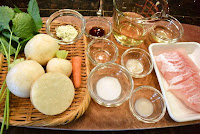


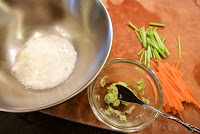




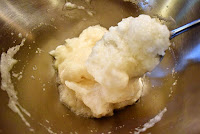





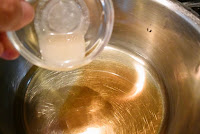
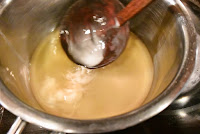

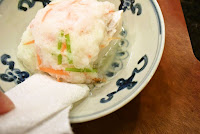


No comments:
Post a Comment